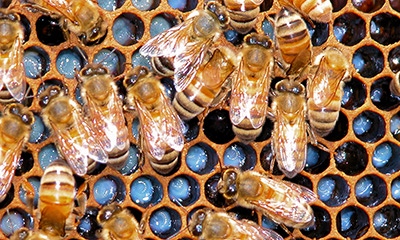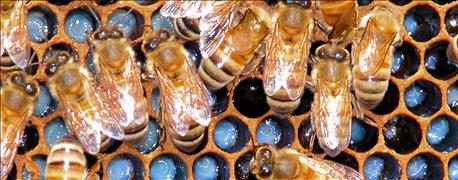July 12, 2016

FAQ: During the recent National Pollinator Week, USDA announced key measures to improve pollinator health. Several of them have to do with the Conservation Reserve Program. Please explain.

PROTECT POLLINATORS: Recently, USDA announced new efforts to improve pollinator health. The Conservation Reserve Program currently provides 15 million acres of healthy forage for pollinators; a new partnership will ensure additional high-quality habitat.
Answer: In June during National Pollinator Week and in advance of USDA’s 7th annual Pollinator Week Festival, USDA announced two initiatives in support of the President’s National Strategy to Promote the Health of Honeybees and Other Pollinators, unveiled a year ago. A review of USDA’s most popular conservation program found that farmers and ranchers across the country are creating at least 15 million acres of healthy forage and habitat for pollinators. USDA has also entered into a new partnership with leading honeybee organizations that will help ensure future conservation projects continue to provide benefits to these important species.
“Pollinators are small but mighty creatures who need our help as much as we need theirs. That is why USDA is dedicating resources from all corners of our department to boost their habitat and better understand how to protect them,” said U.S. Ag Secretary Tom Vilsack. “In addition to creating healthy habitat and food for pollinators through our conservation work, USDA research is leading to breakthroughs in pollinator survival that may reverse the declines we’ve seen over the past few decades. We look forward to continued collaboration with America’s beekeepers and honey producers to ensure this work is meaningful and effective.”
Beekeepers can also benefit from USDA’s programs
USDA has signed a Memorandum of Understanding with two honeybee organizations, the American Honey Producers Association and the American Beekeeping Federation, to facilitate an ongoing partnership that will ensure USDA’s conservation initiatives are as advantageous as possible to pollinators and that beekeepers understand how they can benefit from USDA’s conservation and safety net programs.
For several years, USDA’s Farm Service Agency (FSA) and Natural Resources Conservation Service (NRCS) have worked closely with these groups and others to help improve habitat for honeybees and other pollinators in various conservation programs. The National Strategy emphasized the need for public-private partnerships like this one to expeditiously expand pollinator-health initiatives to achieve the scale necessary to make meaningful, long-term improvements.
FSA has programs also provide financial safety net
FSA also plays a critical role in the delivery of programs that provide a safety net for beekeepers who experience losses due to natural disasters, and the agency administers the Emergency Assistance for Livestock, Honeybees and Farm-Raised Fish Program, which provides assistance for the loss of honeybee colonies, in excess of normal mortality, due to Colony Collapse Disorder or other natural causes. These groups have helped to ensure that these safety net programs work well, and they have helped focus research to learn more about the impacts of USDA programs and make continuous improvements. This MOU creates a framework to ensure ongoing, meaningful information sharing to help beekeepers and honeybees into the future.
In addition to this MOU, a review of USDA’s Conservation Reserve Program (CRP) has revealed that farmers and ranchers across the U.S. have created more than 15 million acres of healthy habitat and forage for pollinators through the CRP Program. Of these, 269,000 acres are enrolled in a pollinator-specific initiative, but these creatures are also helped by several other CRP initiatives on private land that provide wildflowers, shrubs and safe nesting sites through measures intended to improve water quality or create bird habitat.
Acreage enrolled in pollinator initiative has tripled
The National Strategy called for 7 million acres of land to be enhanced or restored for pollinators. Since then, USDA has more than tripled the acreage enrolled in CRP’s pollinator initiative, through which USDA helps to cover the cost of planting pollinator-friendly wildflowers, legumes and shrubs, and USDA has increased the limit on this initiative in response to landowner demand so that more acres can be enrolled in the future.
USDA conducted the high-level review of existing conservation practices and other studies by the U.S. Geological Survey and universities to determine which voluntary conservation practices benefit pollinators. FSA continues to work with USGS to assess which strategies work best to support pollinator health, and future studies may indicate that additional acres also can be considered pollinator friendly.
CRP offers incentives to establish pollinator habitat
In its 30th year, CRP provides incentives to farmers and ranchers with the cost of establishing long-term, resource-conserving plant species, such as approved grasses or trees (known as “covers”) to control soil erosion, improve water quality and develop wildlife habitats on marginally productive agricultural lands. This helps to combat global climate change and provides resiliency to future weather changes. This analysis shows that among its many other benefits, CRP also is extraordinarily beneficial to protecting and promoting pollinator species, from honeybees to monarchs, that are essential to agricultural health.
In addition to CRP, other conservation programs like the NRCS Environmental Quality Incentives Program and the Conservation Stewardship Program have enabled landowners to make pollinator-friendly improvements on working lands. This voluntary conservation work also strengthens agricultural operations, supports other beneficial insects and wildlife, and helps to sustain natural resources. More than three dozen NRCS conservation practices, such as prescribed grazing and cover crops, can provide direct benefits to pollinators. In recent years, NRCS has launched targeted efforts to help honeybees and monarch butterflies to accelerate efforts to create habitat.
Research and outreach agencies are also involved
USDA’s research and outreach agencies are working in other ways to contribute to the President’s National Strategy to Promote the Health of Honeybees and Other Pollinators. For example, the U.S. Forest Service is also conducting research on pollinators while restoring and improving pollinator habitat on national forests and grasslands. Over the past six years, the USDA's Agricultural Research Service has invested more than $82 million in cutting-edge pollinator research and over the past decade has published nearly 200 journal articles about pollinators.
USDA’s People’s Garden Initiative has launched a number of efforts to expand pollinator public education programs, including a bee cam that gives real time insight into the 80,000 bees who live on the roof of USDA’s headquarters and pollinate the surrounding landscape.
More information available on pollinator programs
This fact sheet has more information about USDA’s work to keep pollinators buzzing and contributing to a diverse domestic and global food supply. To learn more about FSA’s conservation programs visit fsa.usda.gov/conservation or contact a local FSA county office. To find your local FSA office visit offices.usda.gov.
You May Also Like




